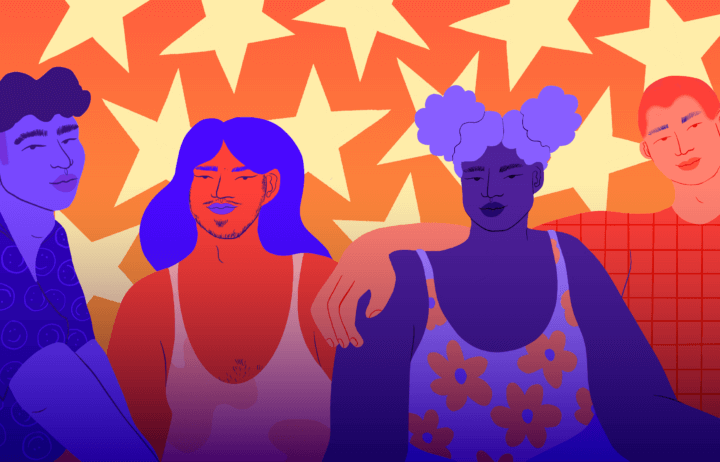Welcome!
The first step to becoming an ally to transgender and nonbinary people is to learn more; thank you for taking that step with us!
It can be tough for transgender and nonbinary people to bear the burden of educating others about their lived experiences. Our Guide to Being an Ally to Transgender and Nonbinary Young People is an introductory educational resource that covers a wide range of topics and best practices on how to support transgender and nonbinary people.
We’re here to help begin your education on the basics of gender identity and expression. You’ll be able to better support the trans and nonbinary folks in your life and help to create a safer, kinder, more accepting world.
Introduction
The support guide includes:
- The difference between sex and gender
- Basics of gender — identity, expression, and perception
- Forms of address that show respect (names, pronouns, honorifics)
- Helpful tips to increase understanding
- Common mistakes and what to do if you’ve made one
Learning is an ongoing experience, so it’s okay to acknowledge that you might not know some things, even after reading this guide. Part of being a good ally is continuing your education, and we’re happy to be part of that journey with you.
Sex and Gender: What’s The Difference?
Many people confuse sex and gender, or use the two interchangeably. Many also wrongly assume that sex defines gender. In reality, gender identity is living, growing, experience that can change over time, and is not necessarily tied to sex.
It can be tough for transgender and nonbinary people to constantly educate or be subjected to the other’s curiosity. One of the best ways to be an ally is to educate yourself on the basics of gender identity and expression so you can better support others.
Understanding Gender Identity
Sex
Sex is the classification of a person as male, female, or intersex. When we are born, doctors usually decide whether female or male will be listed on our birth certificate. This sex assignment at birth is typically based solely on one’s genitals, however sex characteristics also include chromosomes, gonads, and sex hormones. Intersex is an umbrella term used to describe variations in physical sex traits or reproductive anatomy that are present at birth or emerge spontaneously later in life, and differ from normative expectations of “male” and “female.”
Someone’s sex characteristics is private information. When someone shares their gender identity with you, it is invasive and inappropriate to assume or try to deduce that person’s sex assigned at birth. Believe others when they say who they are, and support them.
Gender
Gender describes the internal experience of being a man, a woman, a nonbinary person, or otherwise. Every person experiences gender differently — and you cannot know someone’s gender by simply looking at them.
Common genders include:
- Cisgender: people whose gender identity aligns with the sex they were assigned at birth.
- Transgender: people whose gender identity differs from the sex they were assigned at birth. Some folks might choose to receive certain gender affirming care but this is not necessary and each person should be allowed to choose what works best for themselves.
- Nonbinary: an umbrella term to describe people who experience their gender identity and/or expression outside of the male/female/ man/woman binary, including folks who are genderfluid, genderqueer, polygender, bigender, demigender, agender, and many others.
- Two-Spirit: an umbrella term created by First Nations/Native American/Indigenous peoples to describe a sexual orientation and/or gender/sex that exists outside of colonial constructions of the gender binary (neither man nor woman, but a distinct, alternative gender status exclusive to their ethnicity). This term should not be appropriated by or used to describe people who are not First Nations/Native American/Indigenous.
Understanding Gender Expression
Expression
Gender expression describes the way in which people present or express their gender, including physical appearance, clothing, hairstyles, and behavior. People can exert a certain degree of control over their gender expression depending on their resources and environment.
Perception
A “perceived gender” is based on how people evaluate each other’s gender and bodies, which unlike gender expression, we cannot control. People perceive gender based on a variety of visual and social cues, including but not limited to a person’s gender expression, physical characteristics, and the social role they play.
Being an ally to trans and nonbinary people in your life means refraining from making assumption’s about people’s gender in general. You can’t tell someone’s gender by looking at them. Be aware of the expectations you project onto others based on how you perceive gender, and choose to validate people’s experiences.
Using Names and Pronouns
Respecting the language that young people use to identify themselves is not only polite — it can save lives.
Forms of Address that Show Respect
Using New Names
Some trans and nonbinary people choose a new name that aligns with their gender. It can be something entirely new or a variation on their old name. The process of legally changing your name can be expensive and complicated, and may not be possible for someone right away. Be supportive of trans and nonbinary folks by honoring and using the names they choose regardless of whether their name has been legally changed.
Using Pronouns
A pronoun is a word that is used instead of a noun to refer to someone. Some examples of pronouns that people commonly use include:
- She, her, her, hers, and herself
- He, him, his, his, and himself
- They, them, their, theirs, and themself
- Ze/zie, hir, hir, hirs, and hirself
- Xe, xem, xyr, xyrs, and xemself
- Ve, ver, vis, vis, and verself
We cannot assume someone’s pronouns in the same way we can’t assume people’s gender identities or names. It’s best to always introduce yourself with your pronouns when you meet someone new, which gives them the opportunity to share theirs. Make sure to remember people’s pronouns, and use them correctly.
Honorifics
An honorific is a respectful title or form of address. The honorific Mr., abbreviated from Mister, is sometimes used for men regardless of marital status or age. Ms. is sometimes used for women regardless of marital status or age, and can be used by women who do not want the associations of either Miss (a young, unmarried woman) or Mrs. (a married woman). Recently, Mx. has become a gender-neutral option to anyone who wants a title that can be used regardless of gender, age, or marital status. If you are using honorifics, for example on an intake form or invitation, confirm with the person you are addressing what honorifics they prefer.
Your Identity is Yours to Define
Why Labels Matter
According to our 2022 National Survey on LGBTQ Youth Mental Health, respondents identified with more than 100 sexual orientations and more than 100 gender identities. For many people, labels can be liberating, a way to express themselves and find others who relate to their experiences. Gender is complicated, and there shouldn’t be a limit to the number of words people use to describe themselves.
It’s OK Not to Label Yourself
If your gender is fluid, sometimes it can feel more liberating to not label yourself. For others who are questioning or exploring their gender, going without a label is more comfortable than committing to one right away.
Be careful not to tell others how you think they should or shouldn’t label their gender. Gender is a personal experience. There is no right or wrong way to define your gender, and it’s OK if you don’t want to label yourself either.
Ally Best Practices
Here’s How You Can Support the Trans and Nonbinary People in Your Life
Disclosure
After a friend or loved one shares their experiences with their gender, you may want to inform everyone in your group to make sure that everyone knows to use the correct pronouns, or because you are surprised to find out that someone you know is transgender. Refrain from sharing anyone else’s story for them.
Disclosing a transgender or nonbinary person’s identity could cause discomfort if they have not come out to others. It could also compromise their safety, as many people or environments can be dangerous for transgender and nonbinary people.
Transitioning
Transitioning looks different for different people, and there is no right way to express your gender. Some people physically and/or medically transition; others do not. This may be related to personal expression, lack of access to gender-affirming healthcare, medical conditions that prevent certain procedures, or other reasons.
Transitioning is more complicated than just a surgery, and can take place over a number of years, involving social, medical, and/or legal aspects of transition. Some people decide not to transition at all. This may be for lack of supportive community, risk to personal safety, or other personal reasons. There is no “right” way to express your gender identity or to live your truth.
Under no circumstances should you ask unprompted questions about a transgender or nonbinary person’s body, genitals, medical history, plans for medical procedures, their previous name, or invasive details about their life prior to transition. Imagine how you might feel if a stranger asked you such questions!
Age
There is no “right” age to understand your gender identity. Some people know their gender from a very young age, and supporting them in this has many positive effects on their mental health and well-being. Other people transition later in life, when they are in an accepting environment to do so and have access to social, medical, or legal resources to support them. Other people explore their gender identity over the course of their entire lives. Whatever age they are, it is your responsibility as an ally to uplift them at every stage of their journey.
Understanding Binary and Nonbinary Genders
Gender is not strictly binary, and while some transgender people are binary in their gender identity and expression, others may express their gender as nonbinary, agender, genderfluid, and many more. Nonbinary people often prefer to identify outside binary categories of gender, whereas binary transgender people often want to be accepted simply as men or women.
Sexuality
Transgender and nonbinary people identify with a wide variety of sexualities. Just because you know someone’s gender does not mean you automatically know their sexual orientation.
“Passing”
“Passing” is a term used to describe whether or not a person is perceived as a certain gender; for example, “passing as a woman” or “passing as a man.” For many transgender people, being able to “pass” as the gender they align with is important for a sense of wellbeing, and “passing privilege” can allow one to move safely through environments where being perceived as transgender is a danger.
However, the term can be considered problematic because it implies that being perceived as cisgender is the ultimate goal for transgender and nonbinary people. The word “passing” can imply that a person has to convince others of their gender, rather than being able to simply express their true self. Implying that transgender people are lying, tricking, or deceiving other people is wrong and hurtful.
What To Do If You Misgender Someone
To misgender someone means to use the wrong name, pronouns, or form of address for a person’s gender. Whether misgendering happens as an innocent mistake or a malicious attempt to invalidate a person, it is deeply hurtful and can even put a person’s safety at risk if they are outed as transgender in an environment that is not tolerant.
Purposefully misgendering is not OK, and you can be a good ally by standing up for others if you witness someone being harassed for their gender. If you misgender someone by accident, apologize swiftly without making an excessive show out of the mistake or your guilt, which can create even more discomfort for the person who has been misgendered. Show that you care by doing better moving forward.
Microaggressions
Microaggressions are everyday comments and questions that can be hurtful or stigmatizing to marginalized people and groups. Microaggressions are subtle, and the person committing the microaggression may have no idea that their comments are harmful.
For example, a common comment that transgender people may hear is, “You don’t look trans!” This is often phrased as a compliment, however it implies that being transgender is a negative thing, or that all people want to be perceived as cisgender. Since microaggressions are subtle, do your best and listen to any feedback you may receive. If someone’s feelings are hurt by something you’ve said or done, take the time to understand and to learn from the experience.
Mistakes and Saying Sorry
What To Do If You’ve Offended Someone
While we rarely intend to hurt others, common mistakes such as forgetting a person’s pronouns, using their birth name instead of their chosen name, or misgendering a person can hurt feelings or even put another person’s safety at risk. In these moments, it’s good to have a roadmap for how to make things right.
Listen
Unfortunately, it’s common to avoid listening to those we’ve hurt whether intentional or not, as it inspires uncomfortable feelings of guilt and shame. Stay in your discomfort and be willing to listen, because this is how we can grow.
Seek to understand and empathize with the other person’s lived experience.
Be Accountable
Take responsibility for your actions, privileges, and experiences that you hold which could contribute to your biases. Don’t dismiss what the person is sharing with you, justify your behavior, or defend your intentions. It isn’t helpful to the people who have been hurt, and it shifts the focus away from the people who have been harmed and onto your personal feelings of guilt, shame, or defensiveness.
Remember, intention is not impact. The best apology is one that doesn’t make excuses or invalidate the other person’s feelings.
Commit To Do Better
Treat it as a learning experience. The most authentic apology is meaningless if there is no change or if the behavior is repeated consistently in the future. Show you care by doing better next time.
Conclusion & Other Educational Resources
Exploring gender can be daunting, but it’s also an exciting way to learn about yourself and to express yourself to the world. By learning to support transgender and nonbinary people, you can help to create a safer, kinder, more accepting world.
TrevorLifeline, TrevorText & TrevorChat
LGBTQ young people in search of support can contact The Trevor Project 24/7 through our TrevorLifeline at 1-866-488-7386, via chat at TheTrevorProject.org/Get-Help, or by texting START to 678-678.
Help us continue to provide 24/7 support to LGBTQ+ young people and empower allies to deepen their commitment through advocacy, education, and affirming content.


